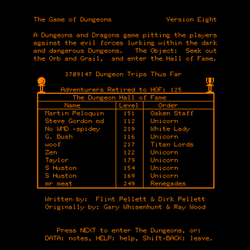- dnd (video game)
-
dnd
Title page of version 8 of dnd (running on a PLATO emulator in 2006)Developer(s) Gary Whisenhunt, Ray Wood Platform(s) PLATO system Release date(s) 1975 Genre(s) RPG dnd is a computer role-playing game. The name dnd is derived from the abbreviation "DND" (D&D) from the original role-playing game Dungeons & Dragons, which was first released in 1975.
The dnd computer game was written in the TUTOR programming language for the PLATO system by Gary Whisenhunt and Ray Wood at Southern Illinois University in 1974 and 1975. Dirk Pellett of Iowa State University and Flint Pellett of the University of Illinois made substantial enhancements to the game from 1976 to 1985.
Contents
Origins
dnd was likely the third dungeon crawl game written for PLATO. The first such game, known as pedit5, was deleted just a few months after it was created. The second game, m199h, was created in a lesson unit (i.e., space on a fixed drive) reserved for foreign language instruction. It was similarly deleted as soon as the illicit program was discovered. dnd was the first PLATO lesson space created for the express purpose of being a dungeon game.
A similar game also named DND and using many of the unique features of the original PLATO dnd was written in BASIC by Daniel Lawrence for the PDP-10 and released around 1977. This second game was later reworked and re-released as Telengard.[1]
The game
In dnd, a player would create a character and then venture into the multi-level Whisenwood Dungeon (a portmanteau of the authors' last names) in search of treasure and the famous 'orb'. The dungeon was populated by an assortment of monsters and treasures.
The game implemented many of the basic concepts of Dungeons & Dragons.
Teleporters moved characters between dungeon levels (especially the Excelsior Transporter, which first appeared in dnd on PLATO). High level monsters, including a Golden Dragon that guards the Orb, are found at the end of each dungeon. Leaving the dungeon allows one to recuperate and regain spells and return later.
Version history
Subsequent revisions of the game added more dungeons, such as The Caverns and The Tomb, with different creatures guarding different treasures (such as the Grim Reaper guarding The Fountain), and the player had to obtain both The Orb and The Grail to win. Also, many different types of miscellaneous treasures were added over the years, with their icons added to the game's original graphical display.
Later PLATO games, such as avatar, oubliette, baradur, moria, dndworld, bnd, and sorcery, were heavily influenced by dnd (and each other) while adding innovative features of their own, from 1976 to 1979.
The game proved enormously popular on PLATO and continues to be played to this day on the NovaNET system and Cyber1. Other dungeon games mentioned in this article can be played on the Cyber1 system (a restoration of a mid-1980s vintage PLATO system).
dnd version 5.4 and dnd 8 are both available on the Cyber1 system as of 10 December 2010[update]. The games have been restored from tape and brought up to current TUTOR language standards by Dirk Pellett.
References
Sources
- "Retro Playing Games", Computer Games, April, 2006, p. 36-37.
External links
- cyber1.org - dnd as well as many other dungeon games can be played on this system.
Categories:- 1975 video games
- Dungeons & Dragons video games
- PLATO games
Wikimedia Foundation. 2010.


